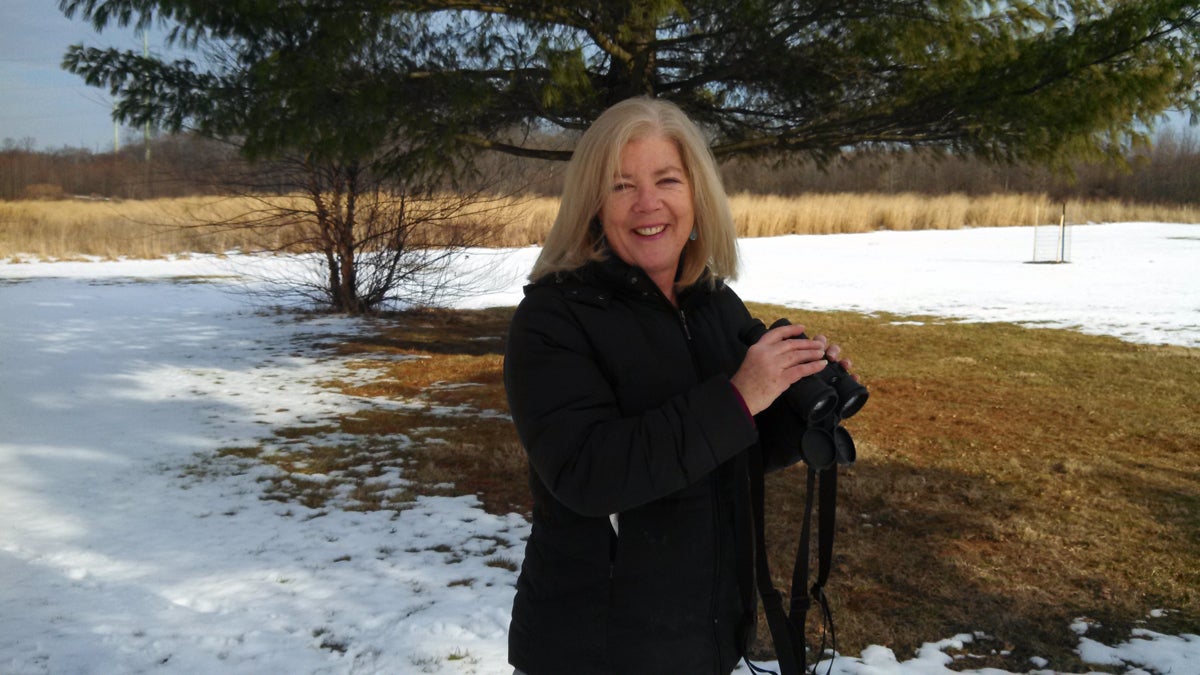How to participate in the Great Backyard Bird Count
Listen
This is the sixth year Pat Evans will be participating in the Great Backyard Bird Count from New Jersey. (Kimberly Haas/for The Pulse)
The Pulse tags along with local birdwatcher Pat Evans as she studies migratory bird patterns and fluxes in bird populations from New Jersey.
When you say “bird watching,” you might think of warm summer days or the first birds of spring. But for ornithologists – scientists who study birds – the important time for watching and counting birds is right now. They need to know how well birds have survived the winter, and where they were located just before spring migrations begin in March.
Bird calls in the winter might sound a little lonely, but in the Philadelphia region, there are actually significant bird populations here throughout the winter. I recently tagged along with birdwatcher Pat Evans, in South Brunswick, New Jersey.
“Those are slate-colored juncos,” Evans said. “You’ll see them all winter in New Jersey.”
Steven Saffier of Audubon Pennsylvania, the state office of the National Audubon Society, lists a few other birds we’re likely to see now.
“Northern cardinals, you’ll see blue jays, you’ll see house finches,” Saffier said. “House sparrows, which is a non-native species. You’ll see mourning doves and probably starlings.”
Some of these species live here year-round. Others fly down here for the winter from more northern areas. And still others have stopped heading south, as our typical winters have been getting warmer. Ornithologists need data on all these migratory patterns, both over large geographic areas, and over time.
So the Audubon Society and Cornell University’s Lab of Ornithology– two major players in the U.S. for the study of birds-teamed up 17 years ago to launch a nationwide project, the Great Backyard Bird Count.
“It’s really getting citizens to go out and count the species on specific four days, that they see,” said Evans.
“And it tells you, are there fluxes in populations, have migrations been affected in any way?” said Saffier. “Is the hard winter having an impact on particular bird species?”
Cornell and Audubon and other world ornithological organizations are looking at those data, analyzing it and coming up with the trends.
This year, the Great Backyard Bird Count will be held on Feb. 14 through Feb. 17. Audubon’s Steven Saffier says it’s easy to get involved.
“All you have to do is bird, either one of the four days or all four days, a minimum of 15 minutes,” he said. “Just look out your back window, count the birds that are there in your yard. You can go to parks, you can go to schoolyards. And you tally that information on a piece of paper and then you submit it online and it all gets bundled up into this data source for Cornell and Audubon.”
But even in cold weather, birds zip around pretty quickly. Steven Saffier notes the most common question they get is, ‘how do I count birds in my backyard and not count the same bird over and over again?’
A simple solution to that is simply to count the highest number of birds of a particular species that you see at any given time. So if you see one goldfinch but later in the day you see 14, you’re going to use that higher number in your tally mark.
This is the sixth year Pat Evans will be counting, and she notes the changes over that time.
“With climate change, we see species in February that we didn’t see before, and we don’t see species that we used to see, because now it’s too warm,” said Evans.
Many folks will literally take a count of the birds right in their backyard. Birding groups and conservation organizations offer Great Backyard Bird Count events, if you’d rather join a group effort.
To find a Great Backyard Bird Count event near you, go to gbbs.birdcount.org. And for more information on this citizen science project and others, go to scistarter.com.
WHYY is your source for fact-based, in-depth journalism and information. As a nonprofit organization, we rely on financial support from readers like you. Please give today.



